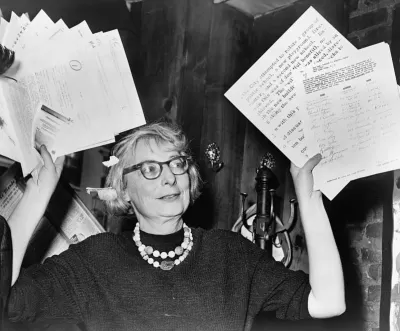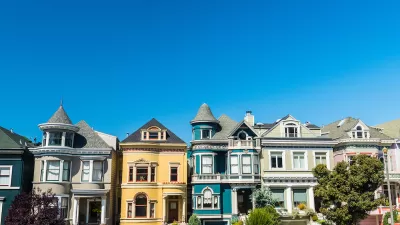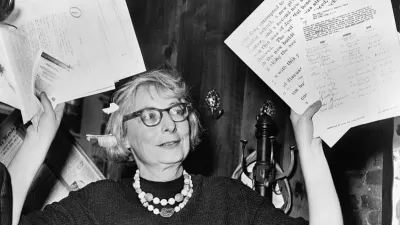The iconic urban thinker has influenced generations of planners, but how do her ideas hold up in an age of massive upheaval and economic inequality?

Writing in Urban Omnibus, Jennifer Hock, Nathan Storring, and Samuel Zipp take stock of the legacy of the so-called "patron saint of city planners," that powerful voice for neighborhood-level urbanism, Jane Jacobs.
While Jacobs' observations on the qualities of vibrant neighborhoods once served as the paragon of urbanist ideals, recently some critics have argued that her ideas are "a relic" that has been "rendered useless in a time of huge-scale urban and global problems." The building blocks she wrote about have become codified "lifestyle amenities for real estate boosterism, instruments of accumulation in the quivers of urban developers" that are created and manipulated to sell high-priced properties to those who can afford them. Whereas Jacobs relentlessly believed in the power of cities as "decentralized, dynamic, always unpredictable human system[s]," activists today argue that too many aspects of "good" urbanism have been captured by "the forces of neoliberalism."
Her failure to address the role of race in urban politics and policies remains a glaring blind spot in her work, but Hock argues that her ideas remain relevant in helping readers understand how to observe and appreciate their city. "We need to bring Jacobs into the 21st century by placing her in dialogue with writers who have thought deeply about the ways in which racism is implicated in the 'sidewalk ballet.'" Saint Jane's ideas may, in some instances, be outdated or myopic, but her clear-eyed observations of city life and emphasis on small-scale decision making and civic duty continue to offer valuable lessons for today's urbanists.
FULL STORY: What About Jane?

Study: Maui’s Plan to Convert Vacation Rentals to Long-Term Housing Could Cause Nearly $1 Billion Economic Loss
The plan would reduce visitor accommodation by 25,% resulting in 1,900 jobs lost.

North Texas Transit Leaders Tout Benefits of TOD for Growing Region
At a summit focused on transit-oriented development, policymakers discussed how North Texas’ expanded light rail system can serve as a tool for economic growth.

Using Old Oil and Gas Wells for Green Energy Storage
Penn State researchers have found that repurposing abandoned oil and gas wells for geothermal-assisted compressed-air energy storage can boost efficiency, reduce environmental risks, and support clean energy and job transitions.

Private Donations Propel Early Restoration of Palisades Playground
Los Angeles has secured over $1.3 million in private funding to restore the Pacific Palisades playground months ahead of schedule, creating a modern, accessible space that supports community healing after recent wildfires.

From Blight to Benefit: Early Results From California’s Equitable Cleanup Program
The Equitable Community Revitalization Grant (ECRG) program is reshaping brownfield redevelopment by prioritizing projects in low-income and environmental justice communities, emphasizing equity, transparency, and community benefits.

Planting Relief: Tackling Las Vegas Heat One Tree at a Time
Nevada Plants, a Las Vegas-based nonprofit, is combating the city’s extreme urban heat by giving away trees to residents in underserved neighborhoods, promoting shade, sustainability, and community health.
Urban Design for Planners 1: Software Tools
This six-course series explores essential urban design concepts using open source software and equips planners with the tools they need to participate fully in the urban design process.
Planning for Universal Design
Learn the tools for implementing Universal Design in planning regulations.
Ascent Environmental
Borough of Carlisle
Institute for Housing and Urban Development Studies (IHS)
City of Grandview
Harvard GSD Executive Education
Toledo-Lucas County Plan Commissions
Salt Lake City
NYU Wagner Graduate School of Public Service




























